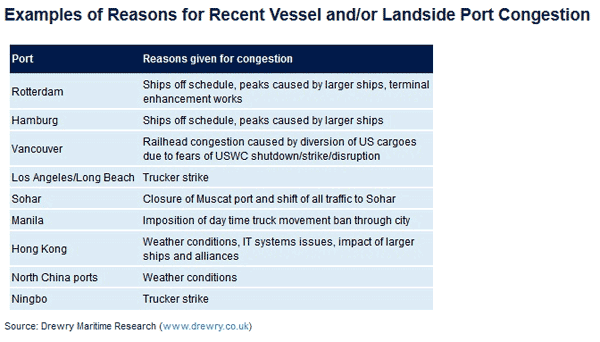From SCDigest's On-Target e-Magazine
- Oct. 8, 2014 -
Global Supply Chain News: Port Delays at LA-Long Beach, Across the World Cause Logistics Headaches
Delays at Ports of LA and Long Beach Getting Severe, with Chassis Issues Continuing to Be Key Source of Problems; "Can't Keep Doing This," Sears Exec Says
SCDigest Editorial Staff
So-called "port congestion," though sometimes really just throughput issues that may or may not really be congestion related, are once again thwarting shippers and importers both in the US and around the world.
At a recent a port congestion hearing called by Mario Cordero, chairman of the Federal Maritime Commission in Washington, D.C., Bob Wysocki, divisional vice president of international transportation and operations at Sears, stated that sometimes it takes as long as one to two weeks to move merchandise out of the port complex in Los Angeles and get it on a train bound for Sears' distribution centers.
SCDigest Says: |
 |
As in the past at LA/Long Beach, and last year at New York/New Jersey, chassis availability to move the containers appears to be a big factor.
|
|
What Do You Say?
|
|
|
|
That's a lot of time having cash tied up in inventory that should be moving much faster.
"We can't keep doing this," Wysocki said, noting the delays are especially acute for goods that are scheduled for promotional pricing campaigns and may not hit store shelves in time.
Larger and larger container ships are being blamed for some of the issues - but that is not really a matter of congestion, which implies there is a sort of gridlock that constrains efficiency. The simple reality is that these megaships are going to take a longer time to unload than it does smaller ships.
"We see it all the time," said Mondo Porras, a crane operator and vice president of the International Longshore and Warehouse Union at the port of LA, where the hearing was held. "You know it's bad when the truckers are blowing their horns because they have been waiting a long time."
The issue is far from being isolated at the ports of LA and Long Beach, though the delays there of course may be the most problematic for US importers.
The port of Manila may be the most challenged of all right now on a global basis. Earlier this year, the port was operating at 98% of theoretical capacity, very high rate. That volume problem has been exacerbated by delays of large infrastructure projects, particularly an elevated road network - called the Skyway project - that would link the port to areas north and south of the capital. The road network, which will connect Manila's north and south expressways, was approved in 1995, but isn't expected to be completed before 2016.
The analysts at Drewry Shipping recently produced the chart below, which identifies a number of ports with throughout issues and the primary cause of the delays.

The Journal of Commerce reports that congestion/delays grew worse over the past weekend in LA and Long Beach, as late peak season merchandise continued to roll in.
John Cushing, president of PierPass Inc., which manages the extended gates program for the 13 container terminals in the port complex, said this week tat terminal operators were spending millions of dollars and taking extraordinary steps to deal with the challenges.
That includes running the very costly "hoot owl" shifts from 3 a.m. to 8 a.m. to get boxes out of the the container yards.
(Global Supply Chain Article Continued Below)
|